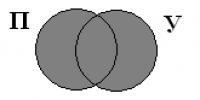Ancient Rome. Roman Empire History of the Ancient World
Slide 1
Slide 2
 Homework: Paragraph 7, notes in a notebook and an oral response on the item “Roman Law”.
Homework: Paragraph 7, notes in a notebook and an oral response on the item “Roman Law”.
Slide 3
 Plan: Early Empire. Principate; Late Empire. Dominant; The emergence of Christianity; Roman law.
Plan: Early Empire. Principate; Late Empire. Dominant; The emergence of Christianity; Roman law.
Slide 4
 Principate and Dominance Find on p. 84 concept of “principate” Principate is a monarchy preserving the external features of a republic. Find on p. 84 concept of “dominant” Dominant is a form of government established by Diocletian (284-305), includes the period of tetrarchy.
Principate and Dominance Find on p. 84 concept of “principate” Principate is a monarchy preserving the external features of a republic. Find on p. 84 concept of “dominant” Dominant is a form of government established by Diocletian (284-305), includes the period of tetrarchy.
Slide 5
 Let's fill out the table: Form of government/current dates Politics Economy Culture Principate Dominance
Let's fill out the table: Form of government/current dates Politics Economy Culture Principate Dominance
Slide 6
 Check: Form of government/present dates Politics Economy Culture Principate (1st century BC - 2nd century AD) Head of state-emperor; A special role is played by the bureaucratic apparatus. Conquest of new territories, spread of Roman state, law, way of life. Construction of cities; Magnificent architectural structures (Flavian Amphitheater, Pantheon Temple); Poetry (Virgil's poem "Aeneid"); Works by historians. Dominant
Check: Form of government/present dates Politics Economy Culture Principate (1st century BC - 2nd century AD) Head of state-emperor; A special role is played by the bureaucratic apparatus. Conquest of new territories, spread of Roman state, law, way of life. Construction of cities; Magnificent architectural structures (Flavian Amphitheater, Pantheon Temple); Poetry (Virgil's poem "Aeneid"); Works by historians. Dominant
Slide 7
 Check: Form of government/dates Politics Economy Culture Principate (1st century BC – 2nd century AD) Dominat (284 – 305) Rule of four – tetrarchy, emperor – “god and lord” . Reforms: administrative, state, municipal, military, judicial, financial. Table of ranks (officials were divided into categories that determined status, payment, and form of address). The process of attaching peasants to the land is the development of colony. Large landowners - magnates - appeared.
Check: Form of government/dates Politics Economy Culture Principate (1st century BC – 2nd century AD) Dominat (284 – 305) Rule of four – tetrarchy, emperor – “god and lord” . Reforms: administrative, state, municipal, military, judicial, financial. Table of ranks (officials were divided into categories that determined status, payment, and form of address). The process of attaching peasants to the land is the development of colony. Large landowners - magnates - appeared.
Slide 8
 Read the paragraph “The Emergence of Christianity...”, p. 86-87, answer the questions: What is “Christianity”? When and where did it originate? Which organization played an important role in the development of Christianity? Who became followers of this religion? Who was the leader of the Christian communities? Who were their helpers? Who is a bishop? What does the term “clear” mean?
Read the paragraph “The Emergence of Christianity...”, p. 86-87, answer the questions: What is “Christianity”? When and where did it originate? Which organization played an important role in the development of Christianity? Who became followers of this religion? Who was the leader of the Christian communities? Who were their helpers? Who is a bishop? What does the term “clear” mean?
Slide 9
 Christianity Christianity (from the Greek Χριστός - “anointed one”, “Messiah”) - world religion, based on the life and teachings of Jesus Christ as described in the New Testament. Christianity arose in the 1st century. in Palestine, which was at that time under the rule of the Roman Empire. Rome persecuted Christians for 3 centuries; they were persecuted throughout the empire, tortured, and executed. But on the contrary, there were more and more Christians.
Christianity Christianity (from the Greek Χριστός - “anointed one”, “Messiah”) - world religion, based on the life and teachings of Jesus Christ as described in the New Testament. Christianity arose in the 1st century. in Palestine, which was at that time under the rule of the Roman Empire. Rome persecuted Christians for 3 centuries; they were persecuted throughout the empire, tortured, and executed. But on the contrary, there were more and more Christians.
Slide 10
 Constantine I the Great (306 – 337) In 313, the Edict of Milan was issued, which allowed Christians to freely practice their religion. In 323 he became the sole ruler. In 325 - the Council of Nicaea - Christianity became the state religion of the Roman Empire. In 330 moved the capital of the state to Byzantium (Constantinople); 395 – division of the Roman Empire into Western and Eastern. Emperor Constantine the Great. Mosaic fragment. Cathedral of St. Sophia in Constantinople. End of the 10th century
Constantine I the Great (306 – 337) In 313, the Edict of Milan was issued, which allowed Christians to freely practice their religion. In 323 he became the sole ruler. In 325 - the Council of Nicaea - Christianity became the state religion of the Roman Empire. In 330 moved the capital of the state to Byzantium (Constantinople); 395 – division of the Roman Empire into Western and Eastern. Emperor Constantine the Great. Mosaic fragment. Cathedral of St. Sophia in Constantinople. End of the 10th century

Civil War Sulla (13878 BC) Title of dictator Introduction of proscriptions (list of executions) Strengthening the role of the army Gaius Marius 157 BC e 86 BC e., -strengthening the army Armament at the expense of the state -contract army service 16 years -payment for service -

At the Forum, signs were posted with the names of those who should have been eliminated; initially they were Sulla’s personal enemies, but then the list began to be replenished with rich Romans who were far from politics. However, it cannot be ruled out that sources may not be aware of the real reason behind the inclusion of seemingly random individuals on the lists. The tablets also contained the rationale for the proscriptions and legally established their various aspects. Thus, the murderer of the proscribed man, who brought Sulla’s head as evidence, received two talents (40 kg) of silver, and if the murderer was a slave, then he received freedom. The informers also received gifts. Death awaited those who sheltered those on the lists. The sons and grandchildren of those convicted were deprived of their citizenship, and the property of those convicted was subject to confiscation in favor of the state. Many of Sulla's associates (for example, Pompey, Crassus, Lucullus) made enormous wealth from property sales and the inclusion of rich people in proscriptions. Crassus, however, was subsequently removed from proscription due to the inclusion of a person in the proscription lists without the consent of Sulla

At that time, the future permanent dictator Gaius Julius Caesar was under threat of death, but his influential relatives managed to persuade Sulla to spare him. According to Plutarch, Sulla said about Caesar to his comrades: “You understand nothing if you do not see that there are many Marius in this boy.” Suetonius recorded a similar version: “Sulla surrendered, but exclaimed, obeying either divine inspiration or his own instinct: Your victory, take it! but know: the one whose salvation you are trying so hard for will someday become destruction for the cause of the optimates, which you and I defended: in one Caesar there are many Maries hidden!

Reign of Caesar CAESAR Gaius Julius (July 13, 100 BC – March 15, 44 BC), Roman politician and commander;. He began his political activity as a supporter of the republic in 49 BC. e., relying on the army, began the struggle for autocracy. Having defeated Pompey and his supporters in BC. e. (Crassus died in 53 BC), found himself at the head of the state. Having concentrated in his hands a number of the most important republican positions (dictator, consul, etc.), he actually became a monarch. Killed as a result of a conspiracy on March 15, 1944






Marcus Ulpius Trajan - the best emperor - campaign against the Dacians - annexation of Armenia and Mesopotamia - a fund to help the poor was created - obliged senators to invest money in the country's economy - strengthening borders - strict implementation of laws (lawyer Papinion)



Caracalla

Soldier Emperor - Diocletian 284 - 305 -Tetrarchy (divided Rome into 4 parts) -Divided the army into court and main -construction -high taxes “Table of Ranks” voluntary renunciation of power (grew cabbage)

Early Empire 3rd century AD e. – Systemic crisis of the empire. External danger. Reduction of slaves. Impoverishment of farmers - Colons (for life). Slave revolts. Reduction in trade. Increase in taxes. "Soldier" emperors. In the army they are provincials. Lack of funds for maintenance. Provinces are trying to break free from Roman control

Late Empire. Konstantin Mr. Roman emperor from 306. Consistently centralized the state apparatus, supported Christian Church, while also preserving pagan cults. In founded the new capital Constantinople. Introduced registration at the place of birth 313 - Ediolan Edict - religious tolerance. Arianism: God the Son is not equal, but “similar” to God the Father. 325 – Council of Nicaea - Creed (code of dogma), condemnation of Arianism. 330 - Capital in Constantinople. Columns to the ground. 395 – Division into Western and Eastern Empires.


Late Empire IV – V centuries. The Great Migration of Peoples. The main enemies are the Germans (Goths, Vandals) and the Huns. 378 - The Goths defeated the Roman army. 408, 410 - Alaric to Rome. Ransom. Liberation of 40 thousand slaves. Again, fall, ruin. 451 – Catalunian fields. Huns. Death of Attila. But: 476 - Odoacer overthrew Romulus Augustus. Imperial regalia to Constantinople. Romulus Augustus presents the crown to Odoacer

1 slide

2 slide

3 slide
Lesson Plan LESSON PLAN: Periodization of Ancient Roman History Roman Civic Community and the Early Republic Making Rome a World Power

4 slide

5 slide
Age of Kings: 753 BC-510 BC (from the founding of Rome to the expulsion of the last of the kings) Early Republic: 510 BC. – mid 3rd century. BC. (from the expulsion of the kings to the Punic Wars) Late Republic, formation of the Roman state: mid-3rd century. BC. – 27 BC Early Empire, Principate: 27 BC – 3rd century AD Crisis – 3rd century. Late Empire, dominant: 4th century AD – 476 (fall of the Western Roman Empire

6 slide
The basis of the Roman people - Romans, Sabines, Etruscans Etruscans - a special influence on Roman history (borrowed: the practice of building cities, the architecture of temples, many crafts) Further development- the Romans, who subjugate the peoples of nearby regions, and then all of Italy. Language – Latin

7 slide
KING (ruler, judge, priest) People's Assembly Senate Council of elders of clans (patricians only) Patrician men, later plebeians 510 BC. – the uprising of the Romans, the overthrow of the last king, a new form of government R E S P U B L I C A

8 slide
Plebeians are descendants of indigenous people conquered by the Romans, aliens. Free people pay taxes, but do not have the right to serve in the army or participate in government. The main occupations are agriculture, crafts, and trade. The fight for civil rights. Patricians - at first a small group of men who came with Romulus, later formed the dominant group in Roman society, had full rights and responsibilities (landowners, service in the army, participation in government) Result of the struggle: Patriciate + plebeian elite = nobility

Slide 9
The main features of the Roman civil community The combination of collective and private land ownership, in the presence of the supreme property of the community The connection between the concepts of “citizen”, “warrior”, “farmer” Equality of political and legal rights of citizens The power of the people’s assembly in all critical issues Opportunities for exploiting fellow citizens as dependent workers, and even more so as slaves, have been significantly reduced. Acceleration of the transformation of foreigners into slaves

10 slide

11 slide
ROME - a world power 265 BC - the entire Apennine Peninsula was captured The struggle of Rome with Carthage - three Punic Wars (264 - 146 BC) The winner Rome captured Spain and North Africa RESULT: CARTHAGE is destroyed by the redivision of the world .

12 slide
SOLVE THE PROBLEM There is information that some Roman rich people at that time had up to 20 thousand slaves. Thus, the slave owner Crassus and Danetry had so many slaves that they could recruit an entire army from them. Pompey actually formed a squadron of 300 of his shepherds; another slave owner had 8,000 thousand slaves. What conclusions can be drawn from these data?

Slide 13
Sources of slavery in Ancient Rome SOURCES OF SLAVERY IN ANCIENT ROME Piracy children of slaves Captives for desertion for debts sale of children into slavery Slave markets In major cities in the center of Rome on the island of Delos

Slide 14
Military victories led to an unprecedented expansion of slavery. A huge number of slaves captured in the war poured into Italy. Gangs also operated at sea and on land, kidnapping people and selling them into slavery. Residents of Roman provinces who did not pay taxes were also enslaved.

15 slide
Slave markets existed everywhere. The main one was in Rome itself at the Forum Boarium. Here the days of selling cattle and slaves alternated. The markets sold not only strong men, but also old people, women and children. Sellers praised their goods, but on the chest of each seller there had to be a sign with a list of physical defects.



